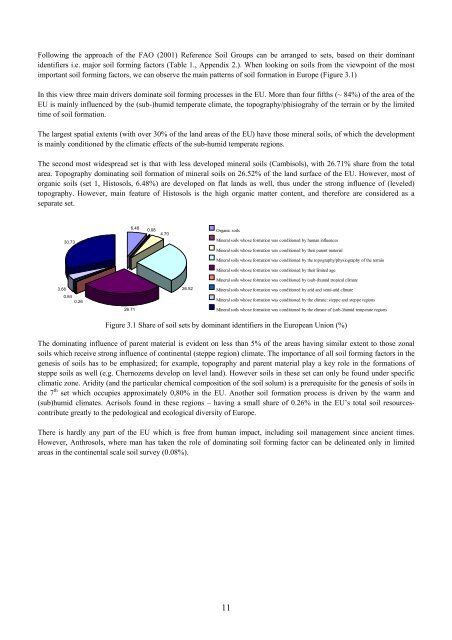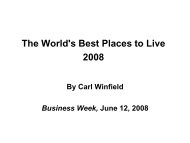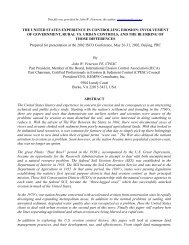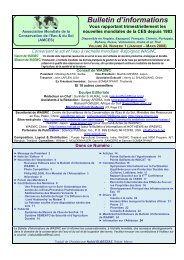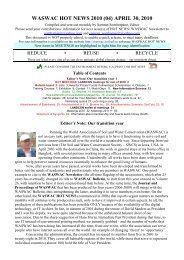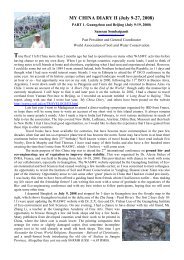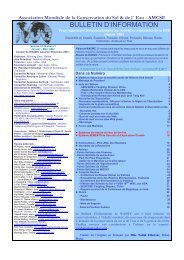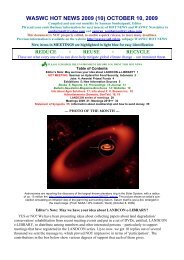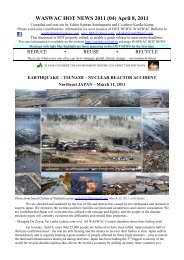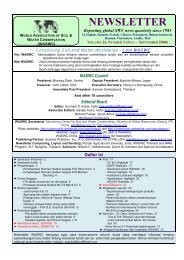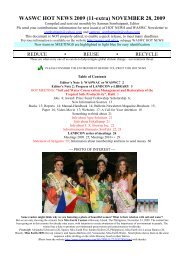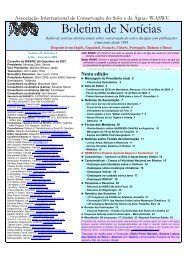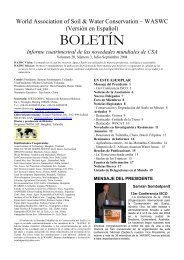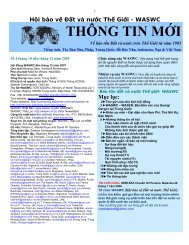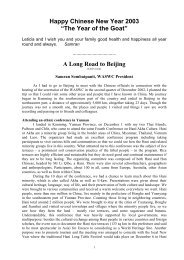Soils of the European Union - European Soil Portal - Europa
Soils of the European Union - European Soil Portal - Europa
Soils of the European Union - European Soil Portal - Europa
You also want an ePaper? Increase the reach of your titles
YUMPU automatically turns print PDFs into web optimized ePapers that Google loves.
Following <strong>the</strong> approach <strong>of</strong> <strong>the</strong> FAO (2001) Reference <strong>Soil</strong> Groups can be arranged to sets, based on <strong>the</strong>ir dominantidentifiers i.e. major soil forming factors (Table 1., Appendix 2.). When looking on soils from <strong>the</strong> viewpoint <strong>of</strong> <strong>the</strong> mostimportant soil forming factors, we can observe <strong>the</strong> main patterns <strong>of</strong> soil formation in Europe (Figure 3.1)In this view three main drivers dominate soil forming processes in <strong>the</strong> EU. More than four fifths (~ 84%) <strong>of</strong> <strong>the</strong> area <strong>of</strong> <strong>the</strong>EU is mainly influenced by <strong>the</strong> (sub-)humid temperate climate, <strong>the</strong> topography/phisiograhy <strong>of</strong> <strong>the</strong> terrain or by <strong>the</strong> limitedtime <strong>of</strong> soil formation.The largest spatial extents (with over 30% <strong>of</strong> <strong>the</strong> land areas <strong>of</strong> <strong>the</strong> EU) have those mineral soils, <strong>of</strong> which <strong>the</strong> developmentis mainly conditioned by <strong>the</strong> climatic effects <strong>of</strong> <strong>the</strong> sub-humid temperate regions.The second most widespread set is that with less developed mineral soils (Cambisols), with 26.71% share from <strong>the</strong> totalarea. Topography dominating soil formation <strong>of</strong> mineral soils on 26.52% <strong>of</strong> <strong>the</strong> land surface <strong>of</strong> <strong>the</strong> EU. However, most <strong>of</strong>organic soils (set 1, Histosols, 6.48%) are developed on flat lands as well, thus under <strong>the</strong> strong influence <strong>of</strong> (leveled)topography. However, main feature <strong>of</strong> Histosols is <strong>the</strong> high organic matter content, and <strong>the</strong>refore are considered as aseparate set.30.736.480.084.70Organic soilsMineral soils whose formation was conditioned by human influencesMineral soils whose formation was conditioned by <strong>the</strong>ir parent materialMineral soils whose formation was conditioned by <strong>the</strong> topography/physiography <strong>of</strong> <strong>the</strong> terrainMineral soils whose formation was conditioned by <strong>the</strong>ir limited ageMineral soils whose formation was conditioned by (sub-)humid tropical climate3.680.840.2626.52Mineral soils whose formation was conditioned by arid and semi-arid climateMineral soils whose formation was conditioned by <strong>the</strong> climate: steppe and steppe regions26.71Mineral soils whose formation was conditioned by <strong>the</strong> climate <strong>of</strong> (sub-)humid temperate regionsFigure 3.1 Share <strong>of</strong> soil sets by dominant identifiers in <strong>the</strong> <strong>European</strong> <strong>Union</strong> (%)The dominating influence <strong>of</strong> parent material is evident on less than 5% <strong>of</strong> <strong>the</strong> areas having similar extent to those zonalsoils which receive strong influence <strong>of</strong> continental (steppe region) climate. The importance <strong>of</strong> all soil forming factors in <strong>the</strong>genesis <strong>of</strong> soils has to be emphasized; for example, topography and parent material play a key role in <strong>the</strong> formations <strong>of</strong>steppe soils as well (e.g. Chernozems develop on level land). However soils in <strong>the</strong>se set can only be found under specificclimatic zone. Aridity (and <strong>the</strong> particular chemical composition <strong>of</strong> <strong>the</strong> soil solum) is a prerequisite for <strong>the</strong> genesis <strong>of</strong> soils in<strong>the</strong> 7 th set which occupies approximately 0,80% in <strong>the</strong> EU. Ano<strong>the</strong>r soil formation process is driven by <strong>the</strong> warm and(sub)humid climates. Acrisols found in <strong>the</strong>se regions – having a small share <strong>of</strong> 0.26% in <strong>the</strong> EU’s total soil resourcescontributegreatly to <strong>the</strong> pedological and ecological diversity <strong>of</strong> Europe.There is hardly any part <strong>of</strong> <strong>the</strong> EU which is free from human impact, including soil management since ancient times.However, Anthrosols, where man has taken <strong>the</strong> role <strong>of</strong> dominating soil forming factor can be delineated only in limitedareas in <strong>the</strong> continental scale soil survey (0.08%).11


